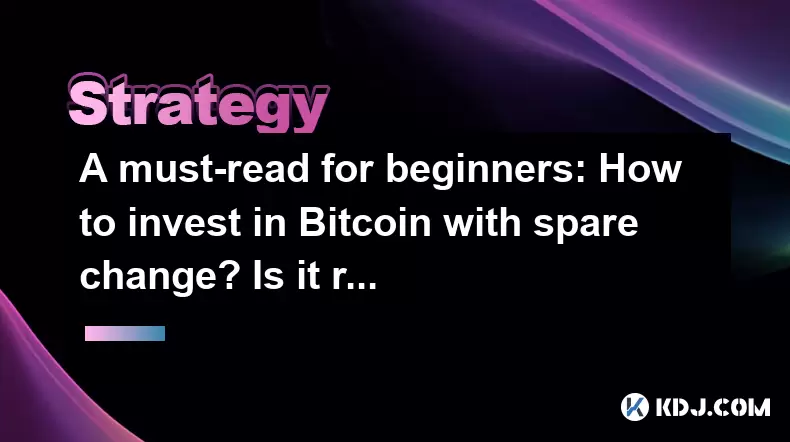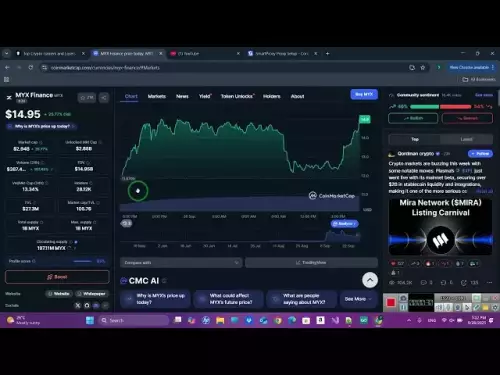-
 bitcoin
bitcoin $109547.008142 USD
0.04% -
 ethereum
ethereum $4011.838726 USD
-0.05% -
 tether
tether $1.000402 USD
-0.01% -
 xrp
xrp $2.798606 USD
0.88% -
 bnb
bnb $970.877944 USD
1.39% -
 solana
solana $202.237275 USD
-0.95% -
 usd-coin
usd-coin $0.999673 USD
0.00% -
 dogecoin
dogecoin $0.229294 USD
-1.15% -
 tron
tron $0.336370 USD
-0.45% -
 cardano
cardano $0.777260 USD
-1.66% -
 hyperliquid
hyperliquid $45.503019 USD
1.73% -
 ethena-usde
ethena-usde $1.000362 USD
0.01% -
 chainlink
chainlink $20.785303 USD
-1.10% -
 avalanche
avalanche $28.755822 USD
-0.11% -
 stellar
stellar $0.358303 USD
-0.48%
A must-read for beginners: How to invest in Bitcoin with spare change? Is it risky?
Investing in Bitcoin with spare change via dollar-cost averaging allows beginners to enter the market gradually, but understanding the risks of volatility and security is crucial.
Jun 06, 2025 at 04:49 pm

Investing in Bitcoin with spare change is an intriguing concept that has gained popularity among beginners looking to enter the cryptocurrency market without a significant financial commitment. This approach allows individuals to gradually build their Bitcoin holdings over time, using small amounts of money that might otherwise go unused. However, as with any investment, there are risks involved, and understanding these risks is crucial before diving into the world of Bitcoin investing.
What is Bitcoin and Why Invest in It?
Bitcoin, often referred to as digital gold, is the first and most well-known cryptocurrency. It operates on a decentralized network, meaning it is not controlled by any central authority like a government or bank. This feature makes Bitcoin attractive to many investors who value financial freedom and security. Investing in Bitcoin can be seen as a way to diversify one's portfolio and potentially benefit from the growth of the cryptocurrency market.
How to Invest in Bitcoin with Spare Change
Investing in Bitcoin with spare change typically involves using a method known as dollar-cost averaging. This strategy entails investing a fixed amount of money at regular intervals, regardless of the market's condition. By doing so, you can buy more Bitcoin when prices are low and less when prices are high, which can help mitigate the impact of volatility.
To start investing in Bitcoin with spare change, follow these steps:
- Choose a reliable cryptocurrency exchange or investment platform: Look for platforms that offer low fees and a user-friendly interface. Some popular options include Coinbase, Binance, and Robinhood.
- Set up an account: Register on the chosen platform, providing necessary personal information and completing any required verification processes.
- Link a payment method: Connect a bank account, credit card, or debit card to your exchange account. Ensure that the platform supports small transactions, as you'll be investing with spare change.
- Determine your investment amount: Decide how much spare change you want to invest regularly. This could be a daily, weekly, or monthly amount, depending on your financial situation and goals.
- Set up recurring purchases: Most platforms allow you to automate your investments. Set up a recurring purchase of Bitcoin for the amount you've decided on, ensuring it aligns with your spare change availability.
- Monitor and adjust: Keep an eye on your investments and the overall market. While dollar-cost averaging helps reduce the impact of volatility, it's still important to stay informed and adjust your strategy if necessary.
The Risks of Investing in Bitcoin with Spare Change
While investing in Bitcoin with spare change can be a low-barrier entry into the cryptocurrency market, it's essential to understand the associated risks. Volatility is one of the most significant risks; Bitcoin prices can fluctuate dramatically in short periods, which can lead to substantial gains or losses.
Another risk to consider is security. Although Bitcoin itself is secure, the platforms and wallets used to store it can be vulnerable to hacks and fraud. It's crucial to choose reputable exchanges and secure your Bitcoin in a wallet that offers robust protection.
Regulatory changes can also impact the value and legality of Bitcoin. Governments around the world are still determining how to regulate cryptocurrencies, and sudden changes in policy can affect the market.
Benefits of Investing in Bitcoin with Spare Change
Despite the risks, there are several benefits to investing in Bitcoin with spare change. Accessibility is a major advantage; anyone with a small amount of disposable income can start investing, making it an inclusive option for those who might not have large sums to invest initially.
Another benefit is potential for growth. Bitcoin has historically shown significant appreciation over time, and even small investments can grow substantially if the market continues to perform well.
Financial education is also a valuable outcome of investing in Bitcoin with spare change. As you navigate the process, you'll learn more about cryptocurrencies, blockchain technology, and investment strategies, which can enhance your overall financial literacy.
Tips for Managing Your Bitcoin Investments
To maximize the benefits and minimize the risks of investing in Bitcoin with spare change, consider the following tips:
- Diversify your investments: While Bitcoin is a popular choice, consider diversifying your portfolio with other cryptocurrencies to spread risk.
- Stay informed: Keep up with the latest news and developments in the cryptocurrency market. This will help you make informed decisions about your investments.
- Use secure storage: Once you've accumulated a significant amount of Bitcoin, consider transferring it to a secure hardware wallet to protect your assets from online threats.
- Set realistic expectations: Understand that investing in Bitcoin with spare change is a long-term strategy. Don't expect quick returns, and be prepared for fluctuations in value.
Understanding the Volatility of Bitcoin
Bitcoin's volatility is a double-edged sword. On one hand, it offers the potential for high returns; on the other, it can lead to significant losses. Volatility is influenced by various factors, including market sentiment, regulatory news, and macroeconomic trends.
To manage volatility, consider the following strategies:
- Long-term perspective: Focus on the long-term potential of Bitcoin rather than short-term fluctuations. This can help you ride out periods of high volatility.
- Rebalancing: Periodically review and adjust your investment portfolio to maintain your desired level of risk and return.
- Stop-loss orders: Some platforms allow you to set stop-loss orders, which automatically sell your Bitcoin if it drops to a certain price, helping to limit potential losses.
Is Investing in Bitcoin with Spare Change Right for You?
Deciding whether to invest in Bitcoin with spare change depends on your financial goals, risk tolerance, and investment strategy. If you're looking for a way to dip your toes into the cryptocurrency market without a significant upfront investment, this approach can be a good starting point.
However, it's important to assess your risk tolerance. If you're uncomfortable with the potential for significant price swings, you might want to consider other investment options. Additionally, ensure that you're not investing money that you might need for essential expenses, as the value of Bitcoin can fluctuate dramatically.
Frequently Asked Questions
Q: Can I invest in Bitcoin with just a few dollars each day?A: Yes, many cryptocurrency exchanges and investment platforms allow you to invest in Bitcoin with as little as a few dollars each day. Platforms like Coinbase and Binance support small, recurring investments, making it feasible to invest with spare change.
Q: How do I know if a cryptocurrency exchange is reputable?A: To determine if a cryptocurrency exchange is reputable, look for factors such as a long history of operation, positive user reviews, strong security measures, and regulatory compliance. Websites like Trustpilot and Reddit can provide insights from other users, and checking for any reported security breaches can also be helpful.
Q: What is the best way to store my Bitcoin securely?A: The best way to store Bitcoin securely is to use a hardware wallet. Hardware wallets like Ledger and Trezor offer offline storage, which significantly reduces the risk of online hacks. Always purchase hardware wallets from the manufacturer's official website to avoid counterfeit products.
Q: How often should I review my Bitcoin investments?A: It's a good practice to review your Bitcoin investments at least once a month. This allows you to stay informed about market trends and make any necessary adjustments to your investment strategy. However, avoid checking your investments too frequently, as this can lead to emotional decision-making based on short-term volatility.
Disclaimer:info@kdj.com
The information provided is not trading advice. kdj.com does not assume any responsibility for any investments made based on the information provided in this article. Cryptocurrencies are highly volatile and it is highly recommended that you invest with caution after thorough research!
If you believe that the content used on this website infringes your copyright, please contact us immediately (info@kdj.com) and we will delete it promptly.
- Snorter Bot: Your Ticket to 100x Crypto Presale Gems?
- 2025-09-29 06:25:16
- XRP Payments, Daily Wages, and Ripple Chief: A Revolution in Payroll?
- 2025-09-29 06:25:16
- XRP, Ripple, and the SWIFT Payments Revolution: A New Era?
- 2025-09-29 06:30:01
- RedotPay, Stablecoin, and Investment: A New Era of Digital Finance?
- 2025-09-29 06:30:01
- MoonBull: The Crypto to Watch in Q4 2025 for APY Rewards
- 2025-09-29 06:30:01
- MoonBull Presale: The Meme Coin Opportunity You Can't Miss (NY Edition)
- 2025-09-29 06:30:12
Related knowledge

Practical parameter settings for a Bitcoin multi-timeframe moving average system
Sep 18,2025 at 10:54pm
Optimizing Timeframe Combinations for Bitcoin Trading1. Selecting appropriate timeframes is crucial when building a multi-timeframe moving average sys...

How can I filter out false breakouts in Dogecoin high-frequency trading?
Sep 22,2025 at 01:00am
Understanding False Breakouts in Dogecoin Trading1. A false breakout occurs when Dogecoin's price appears to move beyond a defined support or resistan...

Techniques for identifying tops and bottoms in the Bitcoin on-chain NVT model
Sep 20,2025 at 07:54pm
Understanding the NVT Model in Bitcoin Analysis1. The Network Value to Transactions (NVT) ratio is often described as the 'P/E ratio' of the cryptocur...

What does the surge in open interest in Bitcoincoin futures mean?
Sep 20,2025 at 11:18pm
Understanding the Surge in Dogecoin Futures Open Interest1. A surge in open interest within Dogecoin futures indicates a growing number of active cont...

How can I use the Ethereum USDT premium to gauge market sentiment?
Sep 18,2025 at 11:55pm
Understanding the Ethereum USDT Premium1. The Ethereum USDT premium refers to the price difference between USDT (Tether) traded on Ethereum-based plat...

What should I do if Ethereum staking yields decline?
Sep 20,2025 at 06:18am
Understanding the Causes Behind Declining Ethereum Staking Yields1. The Ethereum network transitioned to a proof-of-stake consensus mechanism with the...

Practical parameter settings for a Bitcoin multi-timeframe moving average system
Sep 18,2025 at 10:54pm
Optimizing Timeframe Combinations for Bitcoin Trading1. Selecting appropriate timeframes is crucial when building a multi-timeframe moving average sys...

How can I filter out false breakouts in Dogecoin high-frequency trading?
Sep 22,2025 at 01:00am
Understanding False Breakouts in Dogecoin Trading1. A false breakout occurs when Dogecoin's price appears to move beyond a defined support or resistan...

Techniques for identifying tops and bottoms in the Bitcoin on-chain NVT model
Sep 20,2025 at 07:54pm
Understanding the NVT Model in Bitcoin Analysis1. The Network Value to Transactions (NVT) ratio is often described as the 'P/E ratio' of the cryptocur...

What does the surge in open interest in Bitcoincoin futures mean?
Sep 20,2025 at 11:18pm
Understanding the Surge in Dogecoin Futures Open Interest1. A surge in open interest within Dogecoin futures indicates a growing number of active cont...

How can I use the Ethereum USDT premium to gauge market sentiment?
Sep 18,2025 at 11:55pm
Understanding the Ethereum USDT Premium1. The Ethereum USDT premium refers to the price difference between USDT (Tether) traded on Ethereum-based plat...

What should I do if Ethereum staking yields decline?
Sep 20,2025 at 06:18am
Understanding the Causes Behind Declining Ethereum Staking Yields1. The Ethereum network transitioned to a proof-of-stake consensus mechanism with the...
See all articles










































































